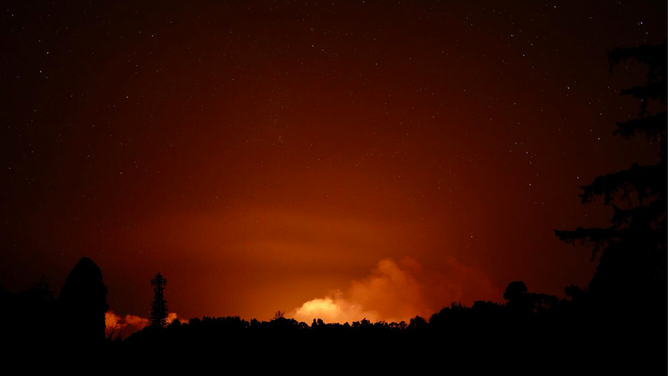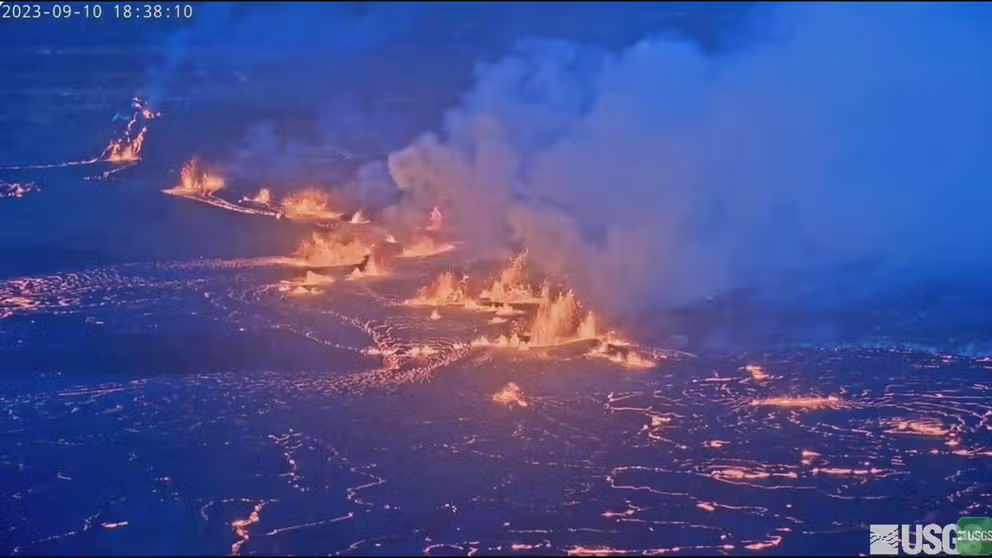Eruption of Hawaii's Kilauea volcano pauses but scientists warn situation can 'change quickly'
Scientists warn that while the current eruption may have stopped, it is "equally likely that it might resume at or to the west of the last active fissure."
Watch: Lava shoots from fissure during eruption of Hawaii's Kilauea volcano
The USGS provided video from the first helicopter flight over the eruption of Hawaii's Kilauea volcano showing lava shooting from a massive fissure on Monday, June 3, 2024.
HAWAII VOLCANOES NATIONAL PARK – Alert levels have been lowered for Hawaii’s Kilauea volcano after a pause in an eruption that began early Monday morning, but scientists warn that the situation remains dynamic and could "change quickly."
According to information provided by the USGS Hawaiian Volcano Observatory (HVO), visual observations at the site showed lava flows began to slow late Monday morning and ceased moving by about 12:30 p.m. local time (6:30 p.m. ET).
HEAVY RAIN TRIGGERED DESTRUCTIVE 2018 KILAUEA VOLCANO ERUPTION, STUDY SUGGESTS

This photo shows lava shooing from a fissure during an eruption of Hawaii's Kilauea volcano on Monday, June 3, 2024.
(USGS / FOX Weather)
Scientists said that areas of incandescence and elevated volcanic gas emissions continued but were decreasing.
The HVO said a sulfur dioxide emission rate of about 15,000 tonnes per day was measured early Monday morning but decreased to about 12,000 tonnes by noon. Scientists say that rate likely continued to decrease during the afternoon hours.
In addition, seismic activity associated with magma moving underground continues to be recorded on the summit but has also slightly decreased in intensity.
WHAT HAPPENS BEFORE A VOLCANO ERUPTS?
The HVO said earthquake activity greatly decreased in the summit region of Kilauea with the onset of the eruption, and all seismicity had been concentrated near Maunaiki along the western extent of cracks that opened during the eruption.
Scientists also observed a slow summit deflation, suggesting that magma may still be flowing from the summit storage area to the southwest into the eruption area.
Video recorded by the U.S. Geological Survey showed lava shooting from fissures during Monday's eruption. And scientists say that although fissure eruptions are often short-lived, they’re difficult to forecast and pauses in activity can sometimes last from hours to days before resuming.
CAN ONE VOLCANO'S ERUPTION TRIGGER AN ERUPTION AT ANOTHER VOLCANO?
Watch: Hawaii's Kilauea Volcano erupts sending lava shooting into the air
The USGS shared video of lava shooting into the air after Hawaii's Kilauea Volcano began to erupt for the third time this year on Sunday. (Video from September 2023)
The cracks that formed during Monday’s eruption extend past the westernmost active fissure, which scientists say showed that magma has moved to the eastern side of Maunaiki, where the most recent earthquake swarms were occurring.
"While the eruption (Monday) occurred due to an intrusion of new magma to the southwest, it occurred in the vicinity of the dike that formed close to the surface on January 31," the HVO said. "Continued input of newer, hotter magma could destabilize the stored magma."
Scientists also warned that while the current eruption may have stopped, it is "equally likely that it might resume at or to the west of the last active fissure."
The HVO said it would continue to monitor Kilauea and would provide additional updates later on Tuesday.








